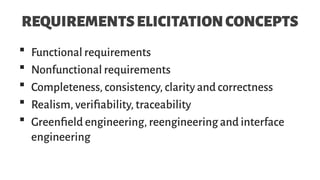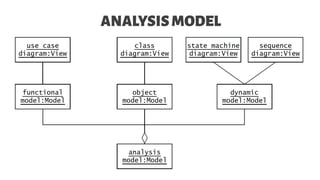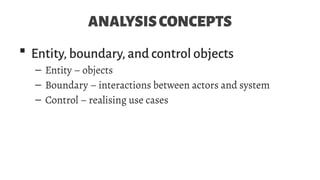Object Oriented Analysis
- 1. OBJECT-ORIENTED SOFTWAREENGINEERING UNIT 04 : Object Oriented Analysis © 2019, PRAMOD PARAJULI
- 2. Disclaimer These slides are part of teaching materials for Object Oriented Software Engineering (OOSE). These slides do not cover all aspect of learning OOSE, nor are these be taken as primary source of information. As the core textbooks and reference books for learning the subject has already been specified and provided to the students, students are encouraged to learn from the original sources. Contents in these slides are copyrighted to the instructor and authors of original texts where applicable.
- 4. REQUIREMENTSELICITATION UNIT 04: Object-oriented Analysis References: Bruegge B., and Dutoit A. H. 2010, Object-oriented Software Engineering using UML, Patterns and Java, 3rd ed., Prentice Hall (Chapter 4) Pressman, R. S., 2001, Software Engineering - A Practitioner's Approach, Fifth Ed., McGrawHill (Chapter 21)
- 6. REQUIREMENTSELICITATIONACTIVITIES Identify actors Identify scenarios Identify use cases Refine use cases Identifying relationships among use cases Identifying nonfunctional requirements Source of information Client-supplied documents Manuals Technical documentation of legacy systems End-user discussions
- 7. TWOMETHODSFORELICITINGINFORMATION Joint Application Design – focuses on building consensus among developers, users, and clients by jointly developing requirements specification Traceability – focuses on recording, structuring, linking, grouping, and maintaining dependencies among requirements and between requirements.
- 8. REQUIREMENTSELICITATIONCONCEPTS Functional requirements Nonfunctional requirements Completeness, consistency, clarity and correctness Realism, verifiability, traceability Greenfield engineering, reengineering and interface engineering
- 9. NONFUNCTIONALREQUIREMENTS Broad variety of requirements that are not related to functional behavior of the system FURPS+ model suggests following categories of nonfunctional requirements – Usability – Reliability – Performance – Supportability
- 10. NONFUNCTIONALREQUIREMENTS Other categories in FURPS+ Implementation requirements (tools, programming languages, hardware platforms) Interface requirements (constrains of interfaces imposed by external systems, legacy systems, end user, data interchange formats etc.) Operations requirements (administration, configuration, management of system in operational setting) Package requirements (delivery of packages, installation media etc.) Legal requirements (accessibility, encryption and security, no-read-up no-write- down etc.)
- 11. Completeness, consistency, clarity and correctness – review the language, sentences, phrases etc. Realism, verifiability, and traceability – use numbers, specific scenarios Greenfield engineering – build system from scratch Reengineering – reverse engineer existing system, redesign and re implement Interface engineering – redesign the user interface of an existing system
- 12. IDENTIFYINGACTORS Nouns that initiate/trigger events
- 13. IDENTIFYINGSCENARIOS Concrete, focused, informal description of a single feature of the system from viewpoint of a single actor
- 16. IDENTIFYINGUSECASES Use cases represent all possible scenarios for given piece of functionality A use case is initiated by an actor A use case may interact with other actors Name of a use case – should be a verb phrase
- 17. ANOTHEREXAMPLE
- 19. REFININGUSECASES
- 21. IDENTIFYINGRELATIONSHIPSBETWEENACTORSANDUSE CASES Communication relationships between actors and use cases Actor who initiates the use case should be distinguished from other actors
- 24. IDENTIFYINGINITIALANALYSISOBJECTS Identify participating objects for each use case. Give proper name and description, build a glossary
- 30. MANAGINGREQUIREMENTSELICITATION UNIT 04: Object-oriented Analysis References: Bruegge B., and Dutoit A. H. 2010, Object-oriented Software Engineering using UML, Patterns and Java, 3rd ed., Prentice Hall (Chapter 4) Pressman, R. S., 2001, Software Engineering - A Practitioner's Approach, Fifth Ed., McGrawHill (Chapter 21)
- 31. MANAGINGREQUIREMENTSELICITATION Negotiating specifications with clients (joint application design) Focuses on building consensus among developers, users, and clients by jointly developing requirements specification
- 33. MANAGINGTRACEABILITY Tracing where requirements came from (who originated it, which client need does it address) to which aspect of the system and the project it affects Helps show the system is complete Focuses on - recording, structuring, linking, grouping, and maintaining dependencies among requirements and between requirements.
- 34. DOCUMENTINGREQUIREMENTSELICITATION 1. Introduction 1.1 Purpose of the system 1.2 Scope of the system 1.3 Objectives and success criteria of the project 1.4 Definitions, acronyms, and abbreviations 1.5 References 1.6 Overview 2. Current system 3. Proposed system 3.1 Overview 3.2 Functional requirements 3.3 Nonfunctional requirements 3.3.1 Usability 3.3.2 Reliability 3.3.3 Performance 3.3.4 Supportability 3.3.5 Implementation 3.3.6 Interface 3.3.7 Packaging 3.3.8 Legal
- 35. DOCUMENTINGREQUIREMENTSELICITATION 3.4 System models 3.4.1 Scenarios 3.4.2 Use case model 3.4.3 Object model 3.4.4 Dynamic model 3.4.5 User interface—navigational paths and screen mock-ups 4. Glossary
- 36. ❃ Read ‘4.6 ARENA Case Study’ from Bruegge B., and Dutoit A. H. 2010, Object-oriented Software Engineering using UML, Patterns and Java, 3rd ed., Prentice Hall (Chapter 4)
- 37. REQUIREMENTSANALYSIS UNIT 04: Object-oriented Analysis References: Bruegge B., and Dutoit A. H. 2010, Object-oriented Software Engineering using UML, Patterns and Java, 3rd ed., Prentice Hall (Chapter 5) Pressman, R. S., 2001, Software Engineering - A Practitioner's Approach, Fifth Ed., McGrawHill (Chapter 21)
- 38. DOMAINANALYSIS
- 40. ANALYSISMODEL
- 41. ANALYSISCONCEPTS Analysis object models and dynamic models – Object model – system, properties and relationships (class diagram) – Dynamic model – behavior of system (sequence diagram, state machine)
- 43. ANALYSISCONCEPTS Entity, boundary, and control objects – Entity – objects – Boundary – interactions between actors and system – Control – realising use cases
- 44. ANALYSISCONCEPTS Generalisation and specialisation – Generalisation – identify abstract concepts from lover- level ones – Specialisation – identify more specific concepts from high-level one
- 45. ANALYSISCONCEPTS Generalisation and specialisation
- 46. ANALYSISACTIVITIES 1. Identifying Entity Objects 2. Identifying Boundary Objects 3. Identifying Control Objects 4. Mapping Use Cases to Objects with Sequence Diagrams 5. Modeling Interactions among Objects with CRC Cards 6. Identifying Associations 7. Identifying Aggregates 8. Identifying Attributes 9. Modeling State-Dependent Behavior of Individual Objects 10. Modeling Inheritance Relationships 11. Reviewing the Analysis Model
- 54. USECASES Define functional and operational requirements of the system by defining a scenario of usage. Provide a clear and unambiguous description of how the end-user and system interact with one another. Provide a basis for validation testing.
- 55. USECASES
- 56. USECASES
- 57. 4.MAPPINGUSECASESTOOBJECTSWITHSEQUENCE DIAGRAMS Shows how the behavior of a use case is distributed among its participating objects Columns of objects Left most column – actor that initiates the use case Horizontal arrows – messages Time proceeds vertically
- 64. 5.MAPPINGINTERACTIONSAMONGOBJECTSWITHCRCCARDS Class-responsibility-collaborator modeling Classes– have characteristics: retained information, needed services, multiple attributes, common attributes, common operations, essential requirements Class types: device class (e.g. sensor) property class (e.g. rating) interaction class (e.g. purchase, license, acquisition)
- 65. MAPPINGINTERACTIONSAMONGOBJECTSWITHCRCCARDS Responsibilities (attributes and operations) Attributes– stable features Operations– processing narrative Five guidelines System intelligence should be evenly distributed Each responsibility should be stated as generally as possible Information and behavior related to it should reside within the same class Information about one thing should be localised with single class, not distributed across multiple classes. Responsibilities should be shared among related classes, when appropriate.
- 66. MAPPINGINTERACTIONSAMONGOBJECTSWITHCRCCARDS Collaborations fulfill their responsibilities in one of two ways; – A class can use its own operations to manipulate its own attributes – A class can collaborate with other classes
- 67. CRCCARDS
- 68. 6.IDENTIFYINGASSOCIATIONS An association shows relation between two or more classes. Have several properties; – Name – Role – Multiplicity
- 69. ELIMINATINGREDUNDANTASSOCIATION Redundant associations should be removed. e.g.
- 70. 7.IDENTIFYINGAGGREGATES Aggregation – denotes whole-part relationship The diamond part – represents whole Two types of aggregation – Composition aggregation – Shared aggregation
- 72. 8.IDENTIFYINGATTRIBUTES Attributes– properties of individual objects, least stable part Properties are different to attributes! First identify as many associations as possible before identifying attributes Attributes have; – Name – Brief description – Type
- 74. 9.MODELINGSTATE-DEPENDENTBEHAVIOROF INDIVIDUALOBJECTS Sequence diagrams - distribute behavior across objects Sequence diagrams - represent the behavior of the system from the perspective of a single use case. State machine diagrams- represent behavior from the perspective of a single object By modeling state change upon certain event, enables a developer to detail use cases.
- 77. 11.REVIEWINGTHEANALYSISMODEL Analysis model is build incrementally and iteratively. When number of changes become minimal in iterations, then the model is stable. Need to look for a model that is – Correct – Complete – Consistent – Realistic
- 78. ACORRECTMODEL? Is the glossary of entity objects understandable by the user? Do abstract classes correspond to user-level concepts? Are all descriptions in accordance with the users’ definitions? Do all entity and boundary objects have meaningful noun phrases as names? Do all use cases and control objects have meaningful verb phrases as names? Are all error cases described and handled?
- 79. ACOMPLETEMODEL? For each object: Is it needed by any use case? In which use case is it created? modified? destroyed? Can it be accessed from a boundary object? For each attribute: When is it set? What is its type? Should it be a qualifier? For each association: When is it traversed? Why was the specific multiplicity chosen? Can associations with one-to-many and many-to-many multiplicities be qualified? For each control object: Does it have the necessary associations to access the objects participating in its corresponding use case?
- 80. ACONSISTENTMODEL? Are there multiple classes or use cases with the same name? Do entities (e.g., use cases, classes, attributes) with similar names denote similar concepts? Are there objects with similar attributes and associations that are not in the same generalization hierarchy?
- 81. AREALISTICMODEL? Are there any novel features in the system? Were any studies or prototypes built to ensure their feasibility? Can the performance and reliability requirements be met? Were these requirements verified by any prototypes running on the selected hardware?
- 83. MANAGINGANALYSISPROCESS Document analysis – using object modelsand dynamic models Requirements analysisdocument 1. Introduction 2. Current system 3. Proposed system 3.1. Overview 3.2. Functional requirements 3.3. Nonfunctional requirements 3.4. System models 3.4.1. Scenarios 3.4.2. Use case model 3.4.3. Object model 3.4.3.1 Data dictionary 3.4.3.2 Class diagrams 3.4.4. Dynamic models 3.4.5. User interface—navigational paths and screen mock-ups 4. Glossary
- 84. ASSIGNINGRESPONSIBILITIES End-user - functions, workflows, data Client – integration role, scope of system Analyst – application domain expert, models current system and future system, detailed use cases Architect – integrates use cases and object models Document editor – documentation Configuration manager – maintains revisions, decompositions Reviewer – validates correctness, completeness, consistency, and clariy
- 85. Revision process
- 86. SELFSTUDY 5.5.3. Analysis communication 5.5.4. Iterating over analysis model 5.5.5. Client sign-off 5.6. ARENA Case Study
- 87. End of Unit 04 : Object-oriented Analysis























































































